Abstract
Ovine trophoblast protein 1 (oTP-1) is the interferon alpha (IFN-alpha) variant with potent antiviral activity and low toxicity that is responsible for maternal recognition of pregnancy in sheep. To examine the structure/function basis for the potent antiviral activity of oTP-1, we have exploited the direct approach of synthetic peptide competition with oTP-1 for receptor, using N-terminal oTP-1-(1-37) and C-terminal oTP-1-(139-172) peptides. These peptides possess structures similar to those predicted for the intact molecule on the basis of circular dichroism. oTP-1-(1-37) at 1.5 mM specifically blocked oTP-1 antiviral activity without affecting the antiviral activity of natural ovine IFN-alpha, recombinant bovine IFN-alpha, and recombinant human IFN-alpha. At concentrations as low as 0.15 mM, oTP-1-(139-172) blocked the antiviral activity of oTP-1, as well as that of natural ovine IFN-alpha, recombinant bovine IFN-alpha, and recombinant human IFN-alpha, but not recombinant bovine interferon gamma. Further, binding of radiolabeled oTP-1 to endometrial membrane preparations could be effectively inhibited by polyclonal anti-C-terminal and anti-N-terminal antisera, with the anti-C-terminal antiserum being the more effective inhibitor. Consistent with peptide and antiserum functional data, oTP-1 and recombinant bovine IFN-alpha are predicted to possess similar C-terminal structure but different N-terminal structure by composite surface profile predictions. The findings suggest that the C-terminal regions of IFN-alpha s bind to a common site on the IFN-alpha receptor while the N-terminal region binds to a site unique for the particular IFN-alpha.
Full text
PDF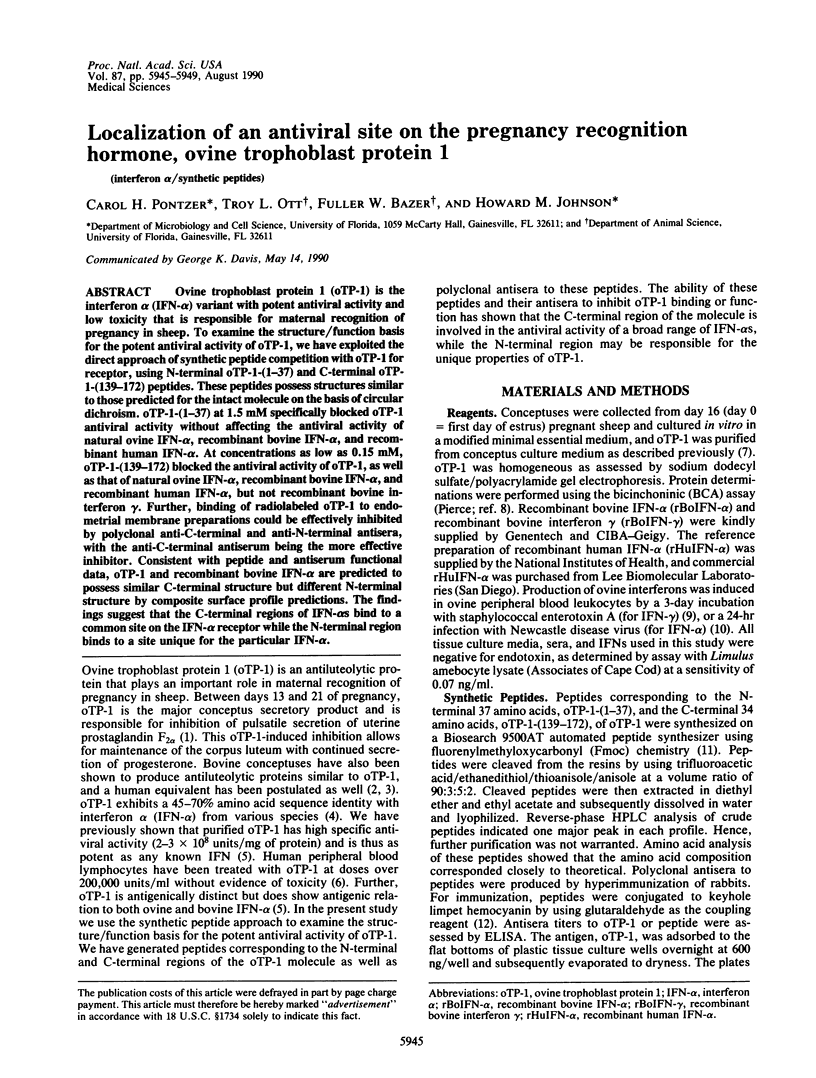
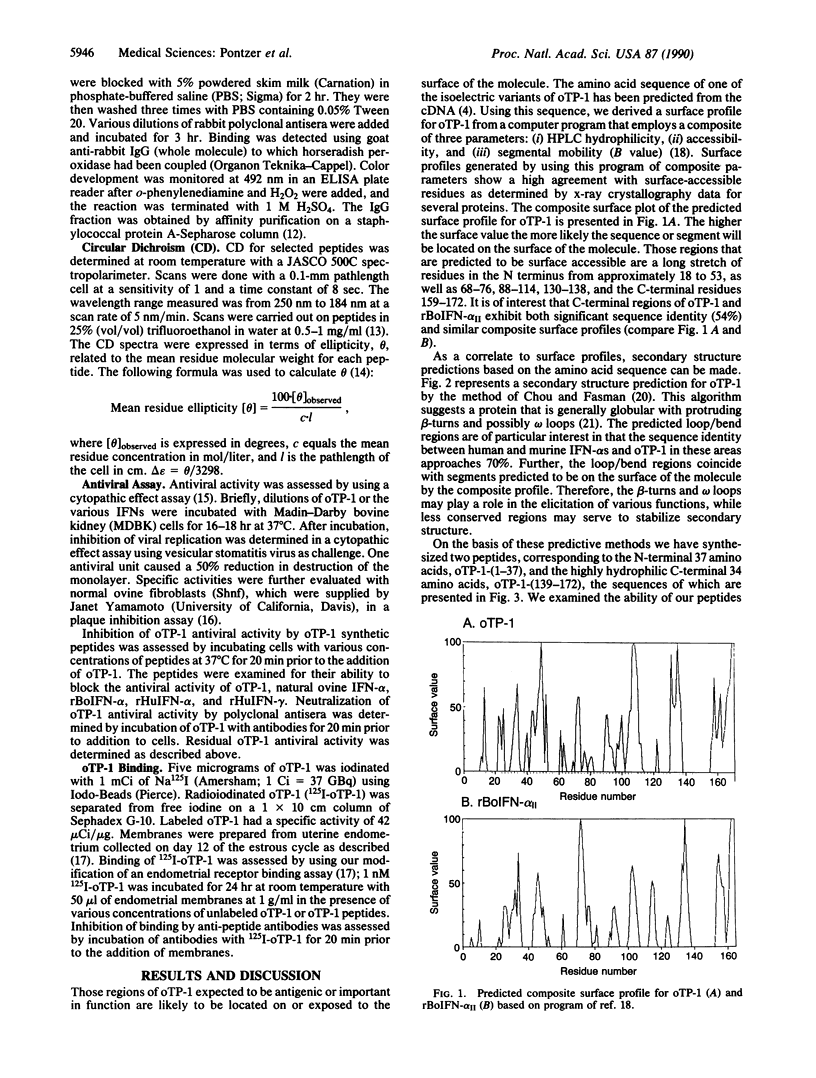
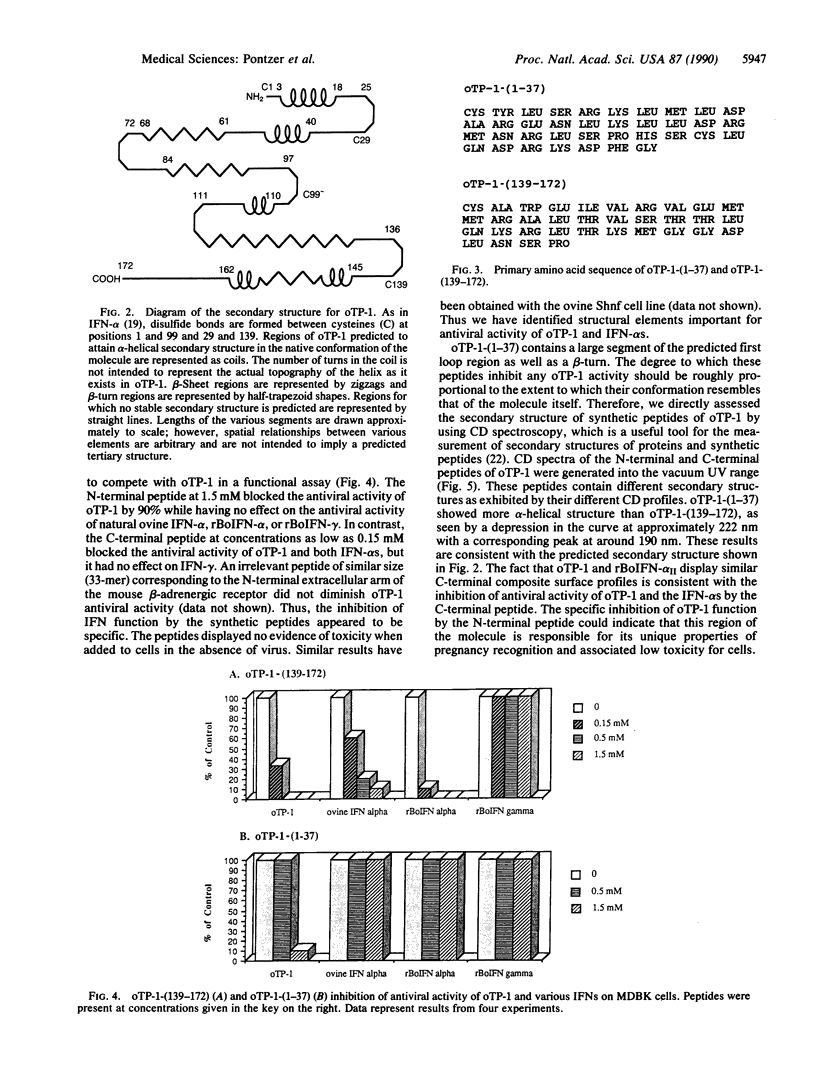
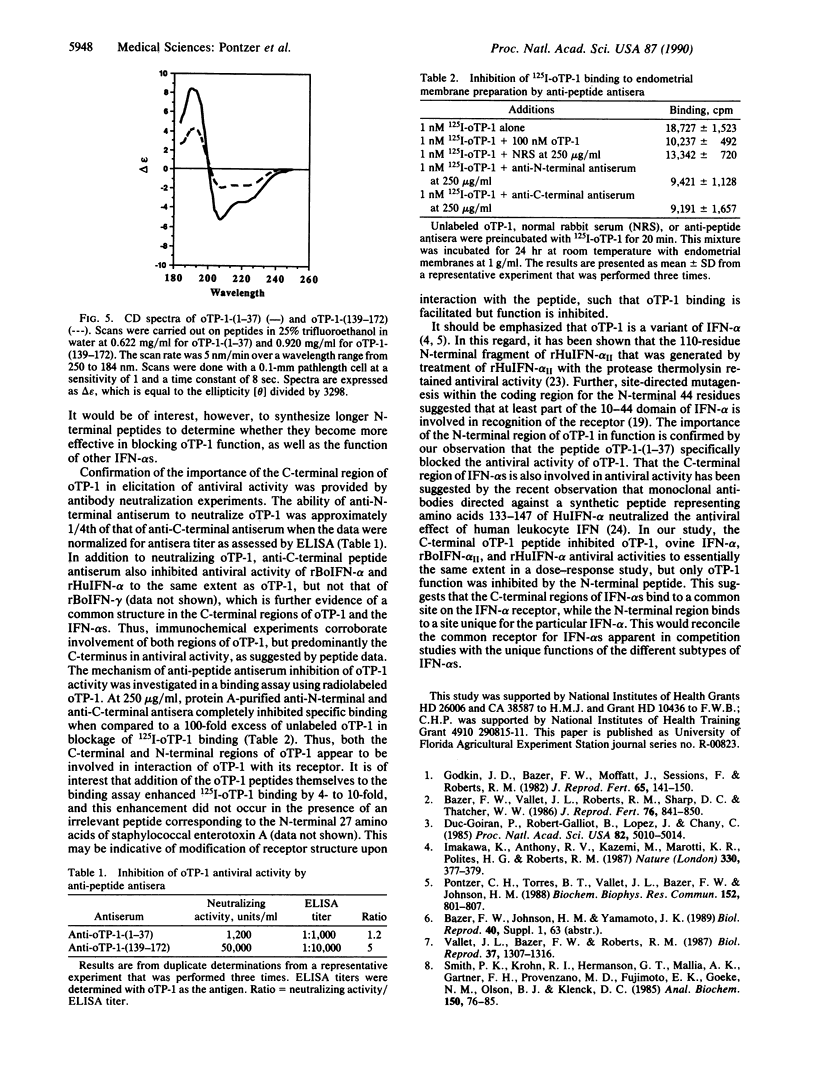
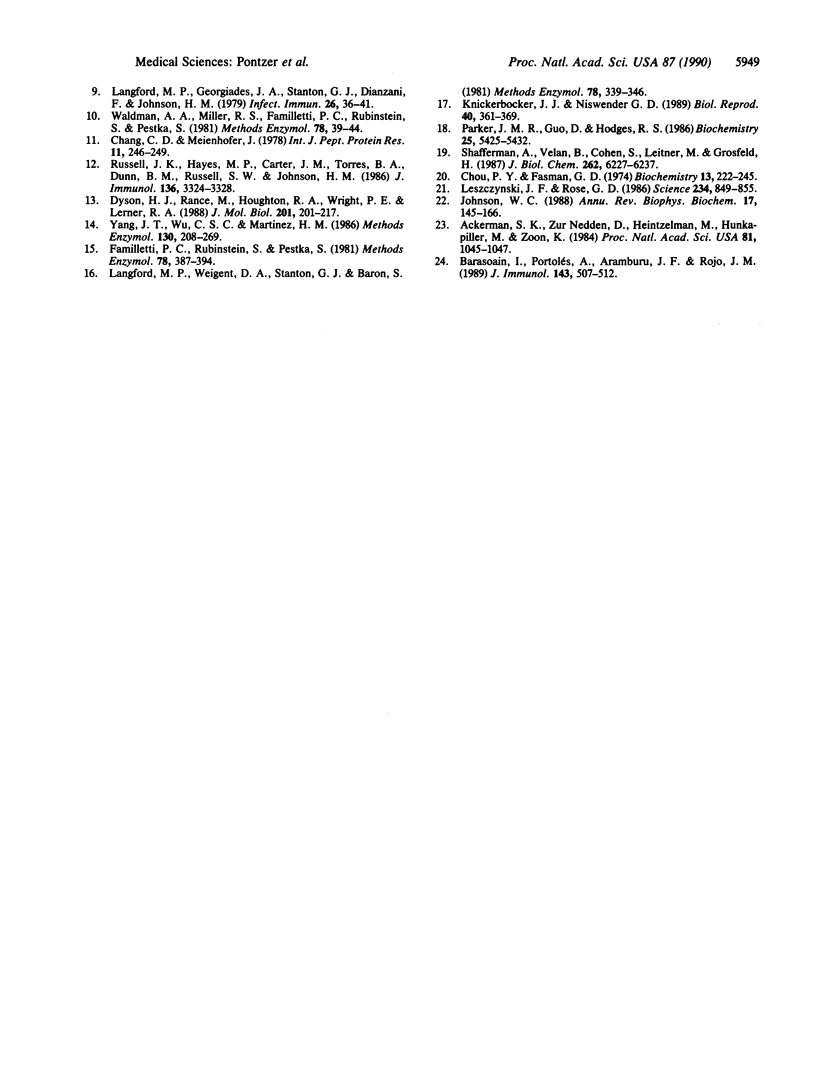
Images in this article
Selected References
These references are in PubMed. This may not be the complete list of references from this article.
- Ackerman S. K., Zur Nedden D., Heintzelman M., Hunkapiller M., Zoon K. Biologic activity in a fragment of recombinant human interferon alpha. Proc Natl Acad Sci U S A. 1984 Feb;81(4):1045–1047. doi: 10.1073/pnas.81.4.1045. [DOI] [PMC free article] [PubMed] [Google Scholar]
- Barasoain I., Portolés A., Aramburu J. F., Rojo J. M. Antibodies against a peptide representative of a conserved region of human IFN-alpha. Differential effects on the antiviral and antiproliferative effects of IFN. J Immunol. 1989 Jul 15;143(2):507–512. [PubMed] [Google Scholar]
- Bazer F. W., Vallet J. L., Roberts R. M., Sharp D. C., Thatcher W. W. Role of conceptus secretory products in establishment of pregnancy. J Reprod Fertil. 1986 Mar;76(2):841–850. doi: 10.1530/jrf.0.0760841. [DOI] [PubMed] [Google Scholar]
- Chang C. D., Meienhofer J. Solid-phase peptide synthesis using mild base cleavage of N alpha-fluorenylmethyloxycarbonylamino acids, exemplified by a synthesis of dihydrosomatostatin. Int J Pept Protein Res. 1978 Mar;11(3):246–249. doi: 10.1111/j.1399-3011.1978.tb02845.x. [DOI] [PubMed] [Google Scholar]
- Chou P. Y., Fasman G. D. Prediction of protein conformation. Biochemistry. 1974 Jan 15;13(2):222–245. doi: 10.1021/bi00699a002. [DOI] [PubMed] [Google Scholar]
- Duc-Goiran P., Robert-Galliot B., Lopez J., Chany C. Unusual apparently constitutive interferons and antagonists in human placental blood. Proc Natl Acad Sci U S A. 1985 Aug;82(15):5010–5014. doi: 10.1073/pnas.82.15.5010. [DOI] [PMC free article] [PubMed] [Google Scholar]
- Dyson H. J., Rance M., Houghten R. A., Wright P. E., Lerner R. A. Folding of immunogenic peptide fragments of proteins in water solution. II. The nascent helix. J Mol Biol. 1988 May 5;201(1):201–217. doi: 10.1016/0022-2836(88)90447-0. [DOI] [PubMed] [Google Scholar]
- Familletti P. C., Rubinstein S., Pestka S. A convenient and rapid cytopathic effect inhibition assay for interferon. Methods Enzymol. 1981;78(Pt A):387–394. doi: 10.1016/0076-6879(81)78146-1. [DOI] [PubMed] [Google Scholar]
- Godkin J. D., Bazer F. W., Moffatt J., Sessions F., Roberts R. M. Purification and properties of a major, low molecular weight protein released by the trophoblast of sheep blastocysts at day 13-21. J Reprod Fertil. 1982 May;65(1):141–150. doi: 10.1530/jrf.0.0650141. [DOI] [PubMed] [Google Scholar]
- Imakawa K., Anthony R. V., Kazemi M., Marotti K. R., Polites H. G., Roberts R. M. Interferon-like sequence of ovine trophoblast protein secreted by embryonic trophectoderm. 1987 Nov 26-Dec 2Nature. 330(6146):377–379. doi: 10.1038/330377a0. [DOI] [PubMed] [Google Scholar]
- Johnson W. C., Jr Secondary structure of proteins through circular dichroism spectroscopy. Annu Rev Biophys Biophys Chem. 1988;17:145–166. doi: 10.1146/annurev.bb.17.060188.001045. [DOI] [PubMed] [Google Scholar]
- Knickerbocker J. J., Niswender G. D. Characterization of endometrial receptors for ovine trophoblast protein-1 during the estrous cycle and early pregnancy in sheep. Biol Reprod. 1989 Feb;40(2):361–369. doi: 10.1095/biolreprod40.2.361. [DOI] [PubMed] [Google Scholar]
- Langford M. P., Georgiades J. A., Stanton G. J., Dianzani F., Johnson H. M. Large-scale production and physicochemical characterization of human immune interferon. Infect Immun. 1979 Oct;26(1):36–41. doi: 10.1128/iai.26.1.36-41.1979. [DOI] [PMC free article] [PubMed] [Google Scholar]
- Leszczynski J. F., Rose G. D. Loops in globular proteins: a novel category of secondary structure. Science. 1986 Nov 14;234(4778):849–855. doi: 10.1126/science.3775366. [DOI] [PubMed] [Google Scholar]
- Parker J. M., Guo D., Hodges R. S. New hydrophilicity scale derived from high-performance liquid chromatography peptide retention data: correlation of predicted surface residues with antigenicity and X-ray-derived accessible sites. Biochemistry. 1986 Sep 23;25(19):5425–5432. doi: 10.1021/bi00367a013. [DOI] [PubMed] [Google Scholar]
- Pontzer C. H., Torres B. A., Vallet J. L., Bazer F. W., Johnson H. M. Antiviral activity of the pregnancy recognition hormone ovine trophoblast protein-1. Biochem Biophys Res Commun. 1988 Apr 29;152(2):801–807. doi: 10.1016/s0006-291x(88)80109-8. [DOI] [PubMed] [Google Scholar]
- Russell J. K., Hayes M. P., Carter J. M., Torres B. A., Dunn B. M., Russell S. W., Johnson H. M. Epitope and functional specificity of monoclonal antibodies to mouse interferon-gamma: the synthetic peptide approach. J Immunol. 1986 May 1;136(9):3324–3328. [PubMed] [Google Scholar]
- Shafferman A., Velan B., Cohen S., Leitner M., Grosfeld H. Specific residues within an amino-terminal domain of 35 residues of interferon alpha are responsible for recognition of the human interferon alpha cell receptor and for triggering biological effects. J Biol Chem. 1987 May 5;262(13):6227–6237. [PubMed] [Google Scholar]
- Smith P. K., Krohn R. I., Hermanson G. T., Mallia A. K., Gartner F. H., Provenzano M. D., Fujimoto E. K., Goeke N. M., Olson B. J., Klenk D. C. Measurement of protein using bicinchoninic acid. Anal Biochem. 1985 Oct;150(1):76–85. doi: 10.1016/0003-2697(85)90442-7. [DOI] [PubMed] [Google Scholar]
- Vallet J. L., Bazer F. W., Roberts R. M. The effect of ovine trophoblast protein-one on endometrial protein secretion and cyclic nucleotides. Biol Reprod. 1987 Dec;37(5):1307–1316. doi: 10.1095/biolreprod37.5.1307. [DOI] [PubMed] [Google Scholar]
- Waldman A. A., Miller R. S., Familletti P. C., Rubinstein S., Pestka S. Induction and production of interferon with human leukocytes from normal donors with the use of Newcastle disease virus. Methods Enzymol. 1981;78(Pt A):39–44. doi: 10.1016/0076-6879(81)78095-9. [DOI] [PubMed] [Google Scholar]
- Yang J. T., Wu C. S., Martinez H. M. Calculation of protein conformation from circular dichroism. Methods Enzymol. 1986;130:208–269. doi: 10.1016/0076-6879(86)30013-2. [DOI] [PubMed] [Google Scholar]




